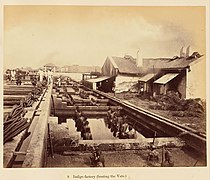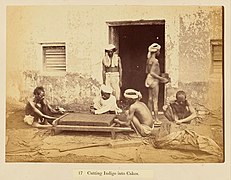Indigo
An indigo shop is a rural business in which plants containing indigo are processed and the blue pigment is separated off. Since harvested plants containing indigo have to be processed quickly, the indigo fields are usually in the immediate vicinity of the indigo fields. The main facilities of an indigo shop are two to three basins, one above the other, in which the indigo plants are processed. Since the synthetic production of indigo, the indigo factories have largely lost their importance for the production of indigo.
Work steps
The extraction of indigo from plants requires several steps, since the dye plants do not contain indigo, but a precursor, the indican , a glycoside of indoxyl . The traditional process involves treatment in a number of tanks at different levels. The fermentation of the freshly cut plants is carried out in the top tank. These are pressed onto the bottom of the pool and poured over with water. At the ambient temperature in tropical countries, the fermentation process begins after a few hours. Hydrolysis of the indane produces indoxyl and glucose, and fermentation produces carbon dioxide . The water turns yellow.
After about 12 hours, the resulting aqueous solution is drained into a second basin below. Air is introduced there by stirring for the oxidation of the indoxyl to indigo. The resulting indigo settles on the bottom of the pool. The supernatant solution is drawn off and the indigo is transferred to a cooking vessel, where it is heated to dryness. Finally, the indigo is filtered and finally dried in air to form a paste and portioned.
- Image gallery: (1) Harvesting the indigo plant; (2), (3) filling the fermentation tank; (4) impact of air; (5) Portioning of the finished indigo
Individual evidence
- ^ Willem van Schendel: The Asianization of Indigo; Rapid change in global trade around 1800 . In: Peter Boomgaard, Dick Kooiman, Henk Schulte Nordholt: Linking Destinies: Trade, Towns and Kin in Asian History . KITLV Press, Leiden, 2008, ISBN 978-90-6718-320-8 , pp. 29-50.





